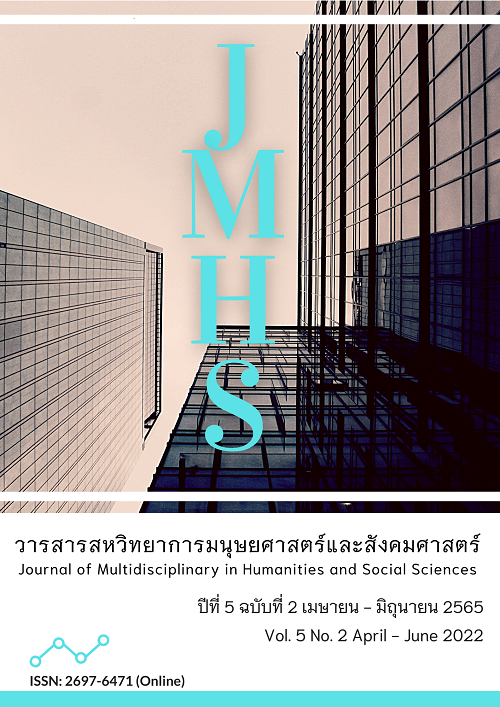Ten Kasina and The Enlightenment Found in Visuddhimagga
Main Article Content
Abstract
The objectives of this article were 1) to study the 10 Kasina found in the Visuddhimagga text and 2) to analyze the 10 Kasina for enlightenment found in Visuddhimagga. The studied data was collected from primary sources of Early Buddhism and other concerned papers, then brought for analysis and finally compiled in descriptive type. The findings revealed an analysis of Kasina for enlightenment found in Visuddhimagga revealed that for Paṭhavīkasiṇa practice, for example, an object of tranquility’s meditation, prior to Vipassana, meditator contemplates at a round mud with 1.4 inches which requires entirely observing as one, not only a participatory object. The perceptual figure of Kasina, an object imagined lying on earth perception was called as Paṭhavikasiṇa. Then having completed 4 form absorptions, and 4 formless absorptions through Paṭhavīkasina concentration, meditator can use it as a base for the Vipassana entrance called as Samathayānika which refers to the mental development by tranquility before insight investigation. This Samathayānika is a mental training for liberation according to Cetovimutti or mentality liberation type, which leads to Arahatship as Ubhatobhāgavimutti etc.
Article Details

This work is licensed under a Creative Commons Attribution-NonCommercial-NoDerivatives 4.0 International License.
Views and opinions appearing in the Journal it is the responsibility of the author of the article, and does not constitute the view and responsibility of the editorial team.
References
จรูญ วรรณกสิณานนท์. (2545). การเพ่งกสิณ: วิธีฝึกปฏิบัติกรรมฐานที่จิตเป็นสมาธิเร็ว. (พิมพ์ครั้งที่ 5). กรุงเทพฯ: พุทธลีลา.
จรูญ วรรณกสิณานนท์. (2550). กสิณกรรมฐานที่ทรงพลัง. (พิมพ์ครั้งที่ 3). กรุงเทพฯ: พุทธลีลา.
บุณย์ นิลเกษ. (2542). คัมภีร์วิสุทธิมรรค สำหรับประชาชน. กรุงเทพฯ: ชมรมชีวานุภาพ.
พระพรหมคุณาภรณ์ (ป.อ. ปยุตฺโต). (2552). พุทธธรรม ฉบับปรับปรุงและขยายความ. (พิมพ์ครั้งที่ 11). กรุงเทพฯ: โรงพิมพ์มหาจุฬาลงกรณราชวิทยาลัย.
พระพรหมคุณาภรณ์ (ป.อ. ปยุตฺโต). (2557). พจนานุกรมพุทธศาสตร์ ฉบับประมวลธรรม. (พิมพ์ครั้งที่ 27). กรุงเทพฯ: โรงพิมพ์มหาจุฬาลงกรณราชวิทยาลัย.
พระพี วชิรญาณมหาเถระ. (2535). สมาธิในพระพุทธศาสนา (สมถกรรมฐาน). (ชูศักดิ์ ทิพย์เกสร, แปล). กรุงเทพฯ: โรงพิมพ์มหาจุฬาลงกรณราชวิทยาลัย.
พระพุทธโฆสเถระ. (2548). คัมภีร์วิสุทธิมรรค. (สมเด็จพระพุฒาจารย์ (อาจ อาสภมหาเถระ), แปล). (พิมพ์ครั้งที่ 6). กรุงเทพฯ: ธนาเพรส.
พระมหากิตติณัฏฐ์ สุกิตฺติเมธี. (2564). การวิเคราะห์แนวทางงดเว้นจากความเสื่อมในปราภวสูตร. วารสารสหวิทยาการมนุษยศาสตร์และสังคมศาสตร์, 4(1), 84-95.
พระมหานพดล นวตลปญฺโญ, พระครูสุธีคัมภีรญาณ (ประมวล) และ พระมหามิตร ฐิตปญฺโญ. (2564). รูปแบบการปฏิบัติธุดงควัตรของพระสงฆ์ในลุ่มแม่น้ำโขง (ไทย-ลาว). วารสารศิลปการจัดการ, 5(2), 325-339.
พระสมชาย บัวแก้ว, พระมหาบุญศรี วงค์แก้ว และ สุเชาวน์ พลอยชุม. (2564). อภิสมาจาร: กระบวนการพัฒนาบุคลิกภาพตามแนวพระพุทธศาสนา. วารสารศิลปการจัดการ, 5(3), 895-907.
มหาจุฬาลงกรณราชวิทยาลัย. (2539). พระไตรปิฎกภาษาไทย ฉบับมหาจุฬาลงกรณราชวิทยาลัย. กรุงเทพฯ: โรงพิมพ์มหาจุฬาลงกรณราชวิทยาลัย.
มหาจุฬาลงกรณราชวิทยาลัย. (2552). อรรถกถาภาษาไทย ฉบับมหาจุฬาลงกรณราชวิทยาลัย. กรุงเทพฯ: โรงพิมพ์มหาจุฬาลงกรณราชวิทยาลัย.
อุไรพร ประชาบุตร และ วิไลศักดิ์ กิ่งคำ. (2564). ศึกษาความสัมพันธ์ระหว่างอานาปานสติกับไตรลักษณ์ ในคัมภีร์พระพุทธศาสนาเถรวาท. วารสาร มจร บาฬีศึกษาพุทธโฆสปริทรรศน์, 7(2), 1-12.
Damnoen, P. S. (2021). The Development of Student Characteristics in According to the Nawaluk Framework of the Buddhist integration of Buddhapanya Sri Thawarawadee Buddhist College. Asia Pacific Journal of Religions and Cultures, 5(2), 126-135.
Phumphongkhochasorn, P., Damnoen, P. S., Suwannaprateep, T., & Phoomparmarn, U. (2021). National Educational Standards and the Improvement of Thai Education System with World Class. Asia Pacific Journal of Religions and Cultures, 5(1), 75-86.
Tan, C. C., & Damnoen, P. S. (2020). Buddhist Noble Eightfold Path Approach in the Study of Consumer and Organizational Behaviors. Journal of MCU Peace Studies, 8(1), 1–20.


